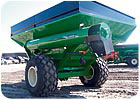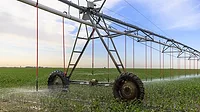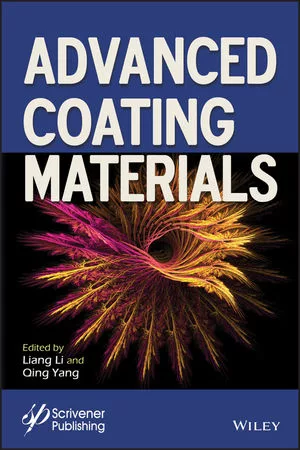Advanced Finishes for Farm Equipment
As agricultural equipment has advanced, coating technology for this demanding market has improved along with it. With modern polyurethane and powder coating formulations, today’s farm equipment manufacturers can achieve durable, high-quality, cost-effective finishes on a range of substrates.

There may be no better example of the impact of technology on daily living than the advances in agricultural equipment over the last two centuries. Developments in this industry have resulted in dramatic shifts in the way people live, eat, produce food and are employed. With the advent of emerging biomass energy crops - particularly corn used as a source of ethanol - manufacturers of agriculture equipment are expecting a boost in the presently flat-to-modest growth in equipment production rates.
While the number of farms in North America has been on the decline for several years, the size of farms has been increasing. As a result, large, corporate farm businesses are the primary market for farm equipment manufacturers, with large rental companies also making up a significant part of their customer base. The industry is highly consolidated, with a handful of companies manufacturing most of the equipment used by today’s farms.
Like the auto industry, the farm equipment industry is being driven by customer demand for a Class “A” finish that looks better longer. As in the truck industry, a trend in the manufacture of farm equipment is the conversion from steel exterior components to composite parts made of materials such as sheet molding compound (SMC) or dicyclopentanedione (DCPD). This conversion is happening in part because composite materials lend themselves to easier styling of body shapes for new models, bringing greater visual impact and excitement to these introductions. When a new model is introduced today, not only is the engineering new (and generally invisible), but the appearance is also new. Tool design also can be more cost-effective than with steel parts.
Additionally, composite parts are more cost-effective than metal for the lower volume production of the agricultural equipment market as compared to automotive market volumes. A production run of a few hundred thousand is typical for the agricultural equipment industry, while millions of a single car model may be produced.
Other factors that have precipitated changes in the finishing of agricultural equipment are changes in the manufacturing processes. Years ago, common manufacturing methods involved assembling primed parts into a unit that was then finish painted with a topcoat. But better manufacturing efficiencies can be realized by assembling components that have already been painted with a coating that has sufficient hardness to resist marring and damage from handling during the assembly process.
The trend to outsourcing has also accelerated the use of more scratch-resistant finish coats, such as polyurethane or powder.

For example, as innovation brought changes and improved properties to DCPD, a primer was developed specifically to improve adhesion to the material. Today, it’s possible to consistently get excellent adhesion to DCPD under a variety of conditions, with no scuffing or sanding prior to priming.
As a result of these changes, the use of polyurethane coatings has been increasing in the manufacture of farm equipment. Polyurethane coatings are particularly well-suited for plastic parts because they only require a force dry for quick film hardness development - typically at 200°F (93°C) or less - compared to a baking system that requires upwards of 225°F (107°C) or more to develop good film performance properties. Good hardness can also be achieved overnight with no bake or force dry required, which is another benefit for these temperature-sensitive substrates.

While two-component polyurethane enamel finishes have been the state-of-the-art since the 1970s, there continue to be advances in this technology that further push the performance envelope and offer key application advantages for OEMs and finishing shops. For example, excellent gloss retention, with very little color or gloss change, over a more than two year Florida exposure is now available without sacrificing film flexibility or chip resistance.
Other advantages of some new generation polyurethane coating systems for farm equipment include better overspray melt-in. This characteristic is particularly significant when painting large surfaces such as harvesters. New generations of primers used in combination with the polyurethane topcoats provide excellent corrosion resistance without the use of passivating rinses in pretreatment. With fast curing, rapid out-of-oven hardness development and excellent “finesse-ability,” these coatings are a good fit for finishing composite components. The film hardness allows the finisher to finesse small blemishes and avoid repainting the entire part-another cost-saving advantage.
While these new polyurethane coatings are best-suited for high-performance applications where the longest-lasting, most mirror-like finish possible is required, there are also polyurethane finish coats specifically formulated to provide good film performance properties at a more competitive price. These coatings typically offer a wider application window, maintain good through-dry and hardness development over metal or plastic substrates, and provide one to three years of outdoor durability.
When using powders, it’s important to pay particular attention to the quality and consistency of metal pretreatment. With good pretreatment, it’s not unusual to get 750 hours salt spray with minimal scribe creep. However, without the proper metal pretreatment, or without the proper maintenance of a pretreatment system, the finish quality of powder coated parts - particularly corrosion resistance and adhesion - plummets. Even five-stage pretreatment systems, if poorly maintained, can diminish corrosion resistance to less than 100 hours. The coating will fail at the scribe because of loss of adhesion to the substrate, indicating potential corrosion problems in the field if the paint film gets nicked or dinged.
Despite its advantages, powder isn’t for every application. For example, some parts cannot be exposed to high temperatures. Powders typically require a 300°F (149°C) or higher metal temperature for a good cure. Some parts are simply too large for a baking finish to be practical. But powder is extremely well-suited for agricultural equipment components such as ladders, undercarriage parts or add-on equipment.
For more information, visit www.sherwin-williams.com/oem.

Parts manufactured for John Deere include panels for combines that are molded on a 3,000-ton large platen press, and a DCPD/SMC combination back-hoe hood. Through superior performance in cost, quality, delivery, and customer support, AIM earned “John Deere Supplier of the Year” Awards for the Construction and Forestry Division in 2005 and the Hay and Harvesting Division in 2006. Case-New Holland is another customer to which the topcoated panels ship ready for direct placement onto the equipment-maker’s assembly line.
AIM’s 132,000-ft2, ISO 9001-certified plant is impressively equipped with 400 3,000-ton compression and reaction injection molding (RIM) presses, a waterjet trimming system and robotic systems for adhesive dispensing and additional part trimming applications. The company’s advanced paint line is capable of handling panels as large as 10 x 6 x 3 ft and producing a high-quality finish that meets the demanding performance specifications of top-tier customers. AIM uses a low-VOC, two-component Polane® HS Plus polyurethane system provided by The Sherwin-Williams Co.
The coating system is applied on a conveyorized paint line complete with power wash, forced air dry off and a paint bake oven. According to AIM Vice President of Operations Scott Pflughoeft, the single-pass prime-topcoat system keeps paint costs low while meeting rigorous requirements for gloss and aesthetic appeal.
“Achieving the finish quality we consistently provide on large parts can be a challenge,” Pflughoeft says, “but we’ve got our line working well.”
In addition to supplying the coatings, the paint company has provided design engineering, technical support and other services to help AIM minimize rejects due to dirt, redesign its paint kitchen for greater efficiency, and train first- and second-shift painters both in the classroom and on the paint line.

Like the auto industry, the farm equipment industry is being driven by customer demand for a Class “A” finish that looks better longer.
There may be no better example of the impact of technology on daily living than the advances in agricultural equipment over the last two centuries. Developments in this industry have resulted in dramatic shifts in the way people live, eat, produce food and are employed. With the advent of emerging biomass energy crops - particularly corn used as a source of ethanol - manufacturers of agriculture equipment are expecting a boost in the presently flat-to-modest growth in equipment production rates.
While the number of farms in North America has been on the decline for several years, the size of farms has been increasing. As a result, large, corporate farm businesses are the primary market for farm equipment manufacturers, with large rental companies also making up a significant part of their customer base. The industry is highly consolidated, with a handful of companies manufacturing most of the equipment used by today’s farms.
Industry Changes
Historically, acrylic and alkyd coatings have been widely used for finishing agricultural equipment - a market category that includes tractors, seeders, balers, fertilizer spreaders, commercial mowing and plowing equipment and harvesters - because these products require good corrosion protection, appearance and durability at a moderate cost. High-gloss, air-dry alkyd enamels can make ideal topcoats for farm equipment with their good gloss retention capability and excellent chemical, impact and chip resistance.Like the auto industry, the farm equipment industry is being driven by customer demand for a Class “A” finish that looks better longer. As in the truck industry, a trend in the manufacture of farm equipment is the conversion from steel exterior components to composite parts made of materials such as sheet molding compound (SMC) or dicyclopentanedione (DCPD). This conversion is happening in part because composite materials lend themselves to easier styling of body shapes for new models, bringing greater visual impact and excitement to these introductions. When a new model is introduced today, not only is the engineering new (and generally invisible), but the appearance is also new. Tool design also can be more cost-effective than with steel parts.
Additionally, composite parts are more cost-effective than metal for the lower volume production of the agricultural equipment market as compared to automotive market volumes. A production run of a few hundred thousand is typical for the agricultural equipment industry, while millions of a single car model may be produced.
Other factors that have precipitated changes in the finishing of agricultural equipment are changes in the manufacturing processes. Years ago, common manufacturing methods involved assembling primed parts into a unit that was then finish painted with a topcoat. But better manufacturing efficiencies can be realized by assembling components that have already been painted with a coating that has sufficient hardness to resist marring and damage from handling during the assembly process.
The trend to outsourcing has also accelerated the use of more scratch-resistant finish coats, such as polyurethane or powder.

As plastics and composites have been improved to offer much better structural properties, so, too, have coating systems evolved.
Material Advances
As plastics and composites have been improved to offer much better structural properties, so, too, have coating systems evolved. In effect, the two technologies have advanced in tandem.For example, as innovation brought changes and improved properties to DCPD, a primer was developed specifically to improve adhesion to the material. Today, it’s possible to consistently get excellent adhesion to DCPD under a variety of conditions, with no scuffing or sanding prior to priming.
As a result of these changes, the use of polyurethane coatings has been increasing in the manufacture of farm equipment. Polyurethane coatings are particularly well-suited for plastic parts because they only require a force dry for quick film hardness development - typically at 200°F (93°C) or less - compared to a baking system that requires upwards of 225°F (107°C) or more to develop good film performance properties. Good hardness can also be achieved overnight with no bake or force dry required, which is another benefit for these temperature-sensitive substrates.

The use of polyurethane coatings has been increasing in the manufacture of farm equipment.
Polyurethane Finishes
Two-component polyurethane enamel finishes provide the high gloss, excellent exterior durability and excellent resistance to abrasion required by the industry. The first generation of this chemistry was sometimes difficult to apply with good appearance under typical production conditions. However, more recent two-component polyurethane formulations offer good application properties using electrostatic conventional spray, high volume low pressure (HVLP) and, most recently, air-assisted airless application equipment. These coatings can be air dried or forced to a hard, impact-resistant finish with excellent color and gloss retention. Further, these coatings can be formulated with less than 3.37 lb/gal volatile organic compounds (VOCs) and very low or no hazardous air pollutants (HAPs) content.While two-component polyurethane enamel finishes have been the state-of-the-art since the 1970s, there continue to be advances in this technology that further push the performance envelope and offer key application advantages for OEMs and finishing shops. For example, excellent gloss retention, with very little color or gloss change, over a more than two year Florida exposure is now available without sacrificing film flexibility or chip resistance.
Other advantages of some new generation polyurethane coating systems for farm equipment include better overspray melt-in. This characteristic is particularly significant when painting large surfaces such as harvesters. New generations of primers used in combination with the polyurethane topcoats provide excellent corrosion resistance without the use of passivating rinses in pretreatment. With fast curing, rapid out-of-oven hardness development and excellent “finesse-ability,” these coatings are a good fit for finishing composite components. The film hardness allows the finisher to finesse small blemishes and avoid repainting the entire part-another cost-saving advantage.
While these new polyurethane coatings are best-suited for high-performance applications where the longest-lasting, most mirror-like finish possible is required, there are also polyurethane finish coats specifically formulated to provide good film performance properties at a more competitive price. These coatings typically offer a wider application window, maintain good through-dry and hardness development over metal or plastic substrates, and provide one to three years of outdoor durability.
Powder Coatings
The use of powder coatings is also on the rise for finishing agricultural equipment. An epoxy powder can provide high levels of corrosion resistance economically, while superdurable triglycidyl isocyanurate (TGIC) polyester powders lend themselves to much more demanding durability specifications. These powders can provide the color and gloss retention of a topcoat and the corrosion resistance of a primer in a single application.When using powders, it’s important to pay particular attention to the quality and consistency of metal pretreatment. With good pretreatment, it’s not unusual to get 750 hours salt spray with minimal scribe creep. However, without the proper metal pretreatment, or without the proper maintenance of a pretreatment system, the finish quality of powder coated parts - particularly corrosion resistance and adhesion - plummets. Even five-stage pretreatment systems, if poorly maintained, can diminish corrosion resistance to less than 100 hours. The coating will fail at the scribe because of loss of adhesion to the substrate, indicating potential corrosion problems in the field if the paint film gets nicked or dinged.
Despite its advantages, powder isn’t for every application. For example, some parts cannot be exposed to high temperatures. Powders typically require a 300°F (149°C) or higher metal temperature for a good cure. Some parts are simply too large for a baking finish to be practical. But powder is extremely well-suited for agricultural equipment components such as ladders, undercarriage parts or add-on equipment.
New Options
As agricultural equipment has advanced, coating technology for this demanding market has improved along with it. With modern polyurethane and powder coating formulations, today’s farm equipment manufacturers can achieve durable, high-quality, cost-effective finishes on a range of substrates.For more information, visit www.sherwin-williams.com/oem.

SIDEBAR: Optimizing Agricultural Finishes
Ashley Industrial Molding, Inc. (AIM) of Ashley, IN, is a prominent supplier to the agriculture industry. The company molds and coats SMC and DCPD parts - particularly large body panels requiring Class “A” finishes - that go directly from the box to its customers’ vehicles.Parts manufactured for John Deere include panels for combines that are molded on a 3,000-ton large platen press, and a DCPD/SMC combination back-hoe hood. Through superior performance in cost, quality, delivery, and customer support, AIM earned “John Deere Supplier of the Year” Awards for the Construction and Forestry Division in 2005 and the Hay and Harvesting Division in 2006. Case-New Holland is another customer to which the topcoated panels ship ready for direct placement onto the equipment-maker’s assembly line.
AIM’s 132,000-ft2, ISO 9001-certified plant is impressively equipped with 400 3,000-ton compression and reaction injection molding (RIM) presses, a waterjet trimming system and robotic systems for adhesive dispensing and additional part trimming applications. The company’s advanced paint line is capable of handling panels as large as 10 x 6 x 3 ft and producing a high-quality finish that meets the demanding performance specifications of top-tier customers. AIM uses a low-VOC, two-component Polane® HS Plus polyurethane system provided by The Sherwin-Williams Co.
The coating system is applied on a conveyorized paint line complete with power wash, forced air dry off and a paint bake oven. According to AIM Vice President of Operations Scott Pflughoeft, the single-pass prime-topcoat system keeps paint costs low while meeting rigorous requirements for gloss and aesthetic appeal.
“Achieving the finish quality we consistently provide on large parts can be a challenge,” Pflughoeft says, “but we’ve got our line working well.”
In addition to supplying the coatings, the paint company has provided design engineering, technical support and other services to help AIM minimize rejects due to dirt, redesign its paint kitchen for greater efficiency, and train first- and second-shift painters both in the classroom and on the paint line.
Looking for a reprint of this article?
From high-res PDFs to custom plaques, order your copy today!






